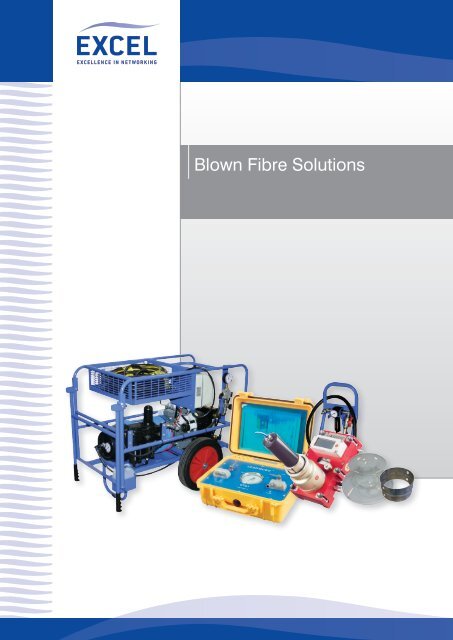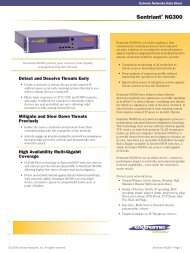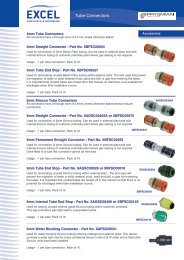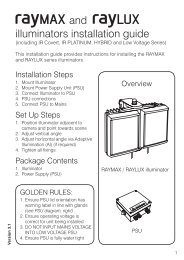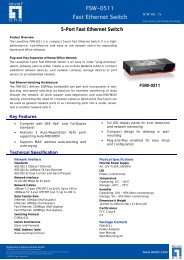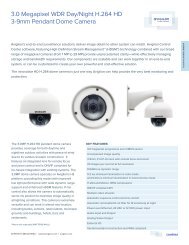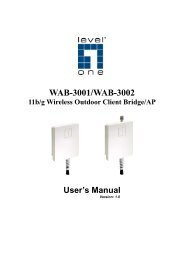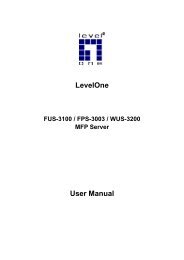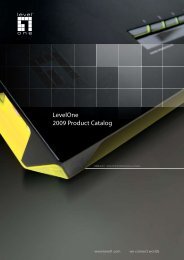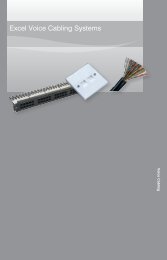Excel Blown Fibre Solutions - Mayflex
Excel Blown Fibre Solutions - Mayflex
Excel Blown Fibre Solutions - Mayflex
Create successful ePaper yourself
Turn your PDF publications into a flip-book with our unique Google optimized e-Paper software.
<strong>Blown</strong> <strong>Fibre</strong> <strong>Solutions</strong>SECTION4
<strong>Blown</strong> <strong>Fibre</strong>The History<strong>Blown</strong> fibre Systems as we know them were originally developed by Pirelli in partnership with British Telecom (BT). Pirelli has spun offits cabling division renaming it Prysmian and has continued to evolve and develop the system resulting in more and more benefits.Today, BT still owns the intellectual property and Prysmian is able to market the product providing an umbrella licence. Part of theagreement is that only trained personnel install the product, and this training is vital, not only to ensure performance, but also toensure good practices and safety.Originally designed for the carrier network, the system is now breaking into the enterprise market and is particularly useful in campusinstallations, including both industrial and office campuses. Recently, with the growth in data centres, the benefits of quick repair,expansion and upgrades are being realised.Real BenefitsAt its simplest, blown fibre uses a series of fitted ducts issued to install fibre between locations. The foundation is the installation of aduct network (the ducts are available in various tube counts and construction meaning internal, direct bury and direct install gradesbetween required locations). The aim is to install the duct cable so that every location is linked, either point to point or, more efficiently,in a loop. Provision should be included for redundant ducting to allow for future expansion. The duct can easily be re-configured if thedesign evolves or changes.The key to a good installation in the enterprise market is to work from the destinations back to the source(s), rather than the traditionalmethod of starting with a large multi-core and breaking it down. This will assure that the minimum number and category of fibre isaccounted for with sufficient future tube capacities. <strong>Blown</strong> fibre is very easy to install and modify, and there are huge time savings.The major benefits to blown fibre are very easy to pinpoint and the comparison to more conventional installation methods is vast.InvestmentOne of the key benefits is by initially investing in a well designed future proofed duct network; the fibre core costs and terminationcan be deferred until actually needed. Then, when a network requires expanding, the new fibre units are blown in quickly and withoutphysical disruption to the fabric of the building or campus. Money is not tied up in having the fibre cores installed, and terminated,for a number of years when they are not being used (and may never be used) and redundant fibre units can be very quickly removedusing the same blowing equipment, making the ducts available for the future. As and when new grades of fibre are developed this canbe quickly and easily deployed as necessary.This approach to staged deployment assists both initial budgeting and future investments. Network Managers can invest on day onein a duct network which is populated with fibres as required. As business needs change, either in terms of capacity or performancerequired, more fibre, or a different class of fibre, can be installed quickly and easily, often when the rest of the network continues tooperate.Repair and UpgradeWhether there is a need to replace a damaged cable or upgrade a larger section of the infrastructure, blown fibre makes it very simple.<strong>Blown</strong> fibre can be described as a ‘plug and play’ solution as that is exactly how the duct cable is joined with push fit connectors. Theducts are installed and the fibre is blown in, it only then needs to be spliced and then the job is complete and ready for use. If damageoccurs to the duct cable and fibre the ‘Mean Time to Repair’ is very fast. Simply locate the damage, open up the outer sheath of theduct cable using standard cable tools, locate the damaged duct(s), cut the duct, blow the fibre unit out, join the duct with push fitconnectors (the section of duct cable can be cut out and replaced if needs be), blow in the replacement fibre unit, terminate & test andthen the fibre is ready for reconnection. What used to take days, now can be reduced to hours to repair. And if some of the ducts haveintact fibre units they do not need to be disconnected or compromised. This is hugely advantageous for data centres where time iscritical and may be subject to costly Service Level Agreements (SLA).How long does it actually take? It can take just a few minutes to remove old fibre and new fibre is blown in at 30 metres per minute,meaning that the whole process, including termination and testing, can be completed within the hour.
Building the SystemIn an industry where Moves, Adds and Changes (MACs) are inevitable, contingency planning becomes vital and finding a solution thatcan allow easy modifications is a much preferable choice.The need for maintenance in itself is greatly reduced by using blown fibre. Blowing fibre is a smooth process as the cable travelseffortlessly down a tube, with no interference. In comparison, using the more traditional pulling method can cause damage to thecable which may shorten its life and may not be evident on day one. The stress it faces means that the need for maintenance becomesfar more likely and its warranty becomes vulnerable. Stress is eliminated when the blown technique is used, as air transports the cablethrough its tube, supporting the fibre core along its entire length, greatly increasing its longevity. The tube cable is installed, with theusual pulling forces applied to any cable, without the fibre unit in place.DiversityA robust network should have more than one path for cable, ensuring that if one path goes down a second can pick up the feed.This can be achieved with any installation method, but blown fibre provides far greater advantages.Consider the requirement to link satellite cabinets back to the main communications room. These may not even be in the samebuilding, for example in a campus environment. Traditionally, multiple fibres would be installed between the cabinets or buildings.Almost every combination of connectivity would need to be considered. If the position of the ‘main’ communications room isswapped, or connectivity between two locations was not considered, this can be a time consuming and a costly exercise.With blown fibre each individual tube can carry a fibre unit consisting of 12 cores. Let us assume that the initial requirement is for nomore than 12 cores to each location. The practice for the blown fibre installation is to install tube cable(s) with a total number of tubesin excess of the number of locations linked to them all in a ring. Ideally twice the number of tubes, to allow for a future expansion orupgrade. So, with this ring, a fibre unit can be installed clockwise and anti-clockwise between two locations offering diversity and onlytying up one tube. Tubes that are not required at a location are not cut. The spares are there for upgrades or expansion. If an 8 core isinstalled and this becomes insufficient then a spare tube could be used to install say a 12 core. When the service is cut over, the 8 coreshould be recovered. That way the spare capacity of the system is maintained.213654
Duct<strong>Fibre</strong> UnitDark <strong>Fibre</strong>Multiple blown fibre ducts contained within a single sheath. Ducts are available in Internal, Direct Install and DirectBury grades with different duct counts. The ducts do not include the fibre unit (fibre optic cores).Multiple cores of fibre bonded together into a single unit for blowing into the tube cable. The fibre is bonded togetherwith an easy to remove substrate. <strong>Fibre</strong> units are available in different categories of fibre optic including OM3, OS2and a combination thereof if required. <strong>Fibre</strong> units can be made with any fibre optic core manufactured or sourced byPrysmian.<strong>Fibre</strong> optic cable that is installed surplus to the immediate requirement. Usually the fibre optic is not terminated andit is referred to as ‘Dark <strong>Fibre</strong>’ as no light is shone down it. If terminated and used, the fibre optic is no longer ‘Dark’fibre.<strong>Blown</strong> fibre truly is a more cost effective, easier and more flexible approach. Fundamentally, as only the tubes are put in on day one, itmeans that the whole cable can be manipulated as needed, offering numerous advantages. Using conventional methods, the cable isfixed in place so the flexibility is non-existent and, should a MAC be required, the time and cost implications could be huge.Future proofedThe ease of modification alone means blown fibre provides a future proofed solution, but further to that Prysmian is also able to turnany optical fibre they make or source into a fibre unit. A system installed a few years ago, before OS2 even existed, can still utilise OS2today, and the unknown ahead of us will still be able to fit into systems that are being installed today.<strong>Blown</strong> <strong>Fibre</strong> from Prysmian<strong>Excel</strong> has partnered with Prysmian to offer their Sirocco ® <strong>Blown</strong> <strong>Fibre</strong> SolutionThe Sirocco ® <strong>Blown</strong> <strong>Fibre</strong> System provides a simple solution to manage evolving networkdemands without the need for high initial capital expenditure or extensive network planning.Sirocco® enables optical networks to adapt to changing business requirements. Sirocco®allows optical fibres to be deployed on demand from one point of a network to another(internal or external) using compressed air to blow optical fibre into pre-installed tubes.The flexibility offered by blown fibre solutions can substantially minimise today’s networkbuild costs. With the many uncertainties in the market, such as future trends in technology, demand from customers, peoplemovement and financial confidence, Sirocco ® can provide a flexible, low total life cost and ‘peace of mind’ solution.Just some of the key benefits include:• It uses new, innovative technology and is state of the art equipment• It uses multiple fibres• <strong>Fibre</strong>s that are blown out can be reused• The blows can be cascaded• It is a total cable solution• It offers integrity and extra length• The tube can be tested before the fibre is blown inAbout Prysmian• Prysmian is a leading player in the industry of high-technology cables and systems for energy and telecommunications• The Prysmian Group sales exceeded 3.7 billion Euros in 2009• Prysmian boasts a global presence with subsidiaries in 39 countries and 56 plants in 24 countries• Prysmian has 7 Research & Development Centres in Europe, USA and South America, and 12,000 employees25 Year WarrantyWhen the Sirocco blown fibre system is installed by an accredited <strong>Excel</strong> Cabling Partner, who has alsoattended the Prysmian Sirocco training course, the installation is covered by the standard <strong>Excel</strong> 25 yearproduct and application warranty.


